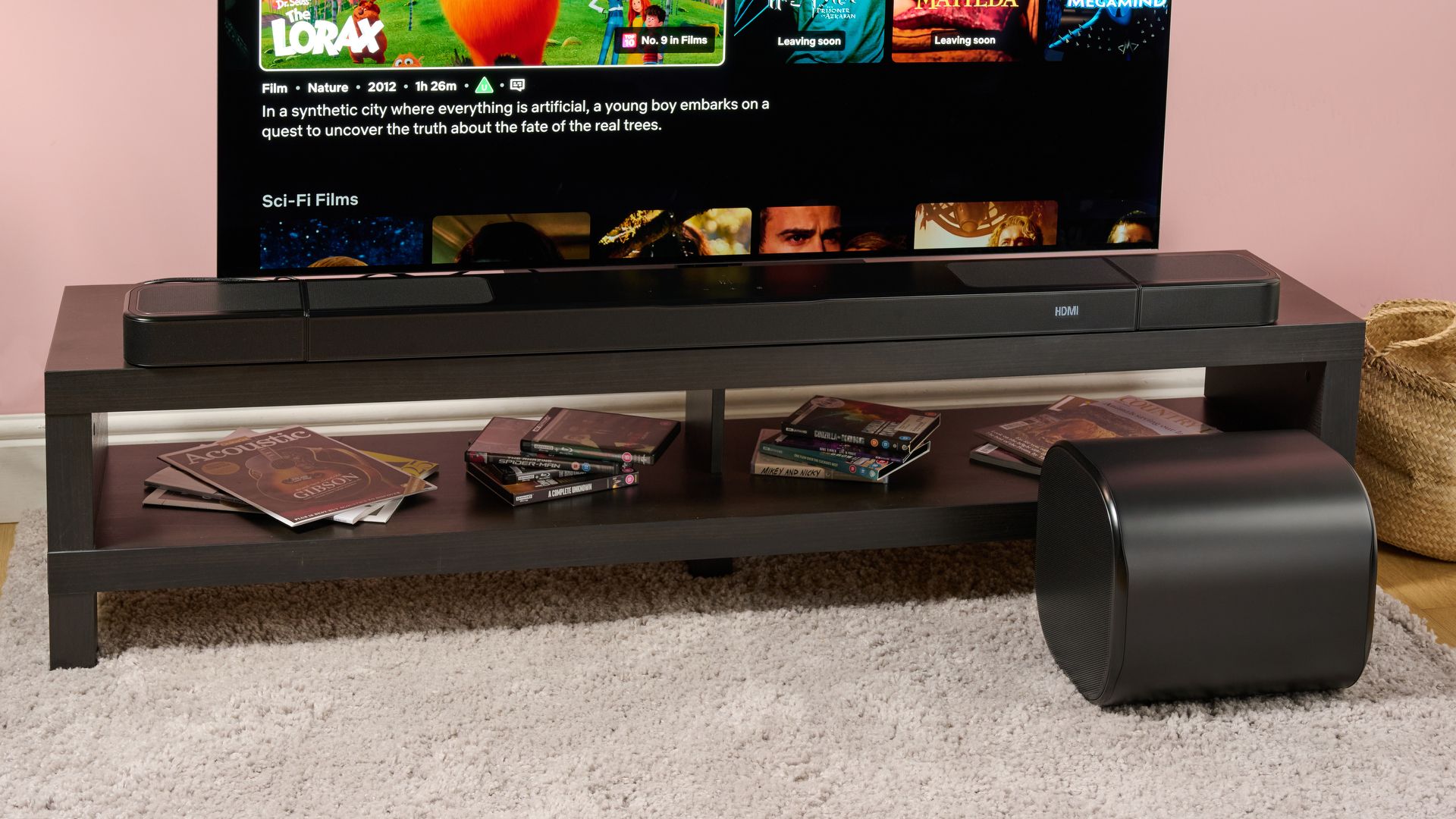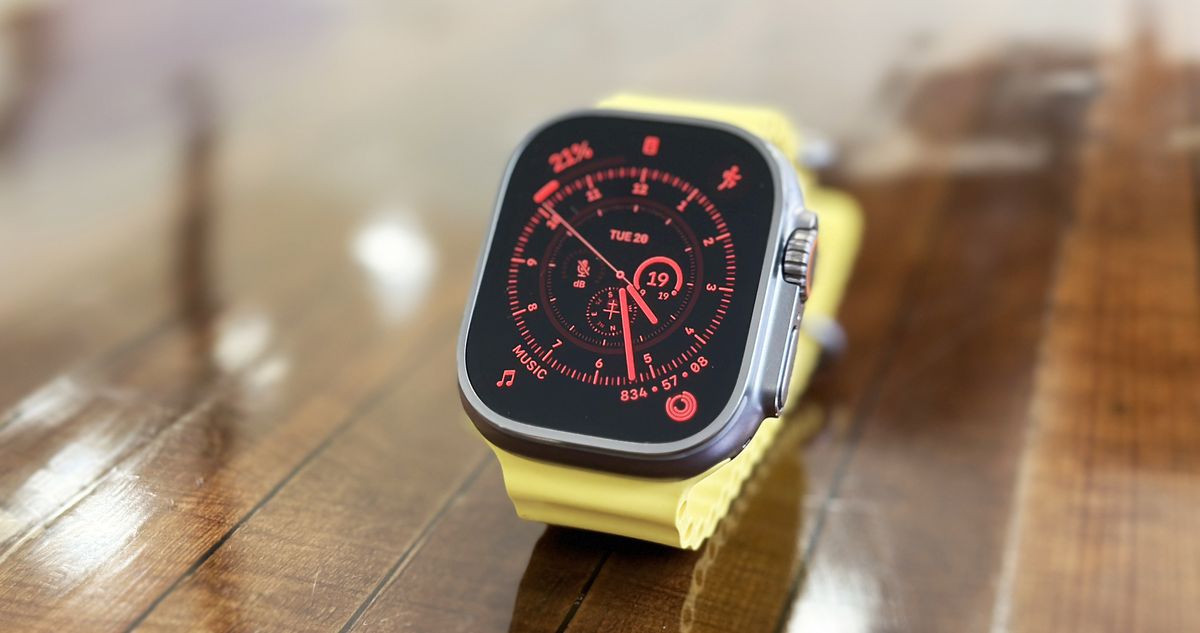Why you can trust TechRadar
We spend hours testing every product or service we review, so you can be sure you’re buying the best. Find out more about how we test.
TP-Link M8550: 30-second review
The TP-Link M8550 offers a way for you to connect through a cellular network to the internet wherever you are without tethering to your mobile phone. It’s one of a growing number of mobile routers that feature Wi-Fi 6E to connect to wireless devices such as your laptop and utilise the same 5G mobile network as your mobile phone.
TP-Link is a big name in networking, and as such, there are a few added extras bundled with this particular mobile router that make it a great option, especially for businesses and if you value security, with a built-in VPN so that you can protect your identity online.
Getting set up to use the TP-Link M8550 is simple enough. Firstly, install the large-capacity battery, give it a charge, pop in a SIM card with its own mobile network contract, then, with any Wi-Fi-enabled device, you can find the TP-Link network and join it as you would with any other Wi-Fi router.
Use really couldn’t be easier, and that large-capacity battery essentially gives up to 14 hours of battery life, which meant, through the test, charging it overnight and packing it into the backpack before I set off on my day’s work, I had internet connection all day. The only issue was that, if the network connection, especially around the New Forest, is low, then unfortunately, however good this router is, you’re still not going to be able to get on the internet. However, sitting in a café in Salisbury city centre with full 5G connectivity, the connection speeds were exceptionally good.
When a colleague needed to hop onto my Wi-Fi network, joining to browse the internet didn’t have any real effect on the speed of my connection. In fact, through the test, connecting up to five devices alongside streaming music in a strong 5G environment didn’t prove too much of an issue for the device.
Whilst I mainly used this mobile router on the move, I also used it as the main internet connection within the workshop and studio, connecting to the wired network so that the 3D printers Prusa Core One and the Bambu Lab P2S could connect in, along with network-attached cameras and other equipment. With a mid-strength 5G connection, all devices connected with decent strength, although one Alexa at the far end of the studio struggled a little, with the connection dropping out on several occasions. However, that was through a brick wall and about 7m from the TP-Link router.
There are other routers out there to choose from, and prices vary, with the M8550 being somewhere in the mid-range. It offers a very solid solution for anyone who needs a mobile internet connection on the move. What I really liked, aside from the fact that I could connect it to a wide network, was the ability to plug in additional antennas. Unfortunately, I didn’t have any for the test, but I would love to have seen whether they would finally give me a workable connection while out in the forest.
Overall, the TP-Link, with all its features and its very elegant and easy-to-use touchscreen interface, is a great option if you’re looking for a well-priced 5G router for your business.
TP-Link M8550: Price and availability
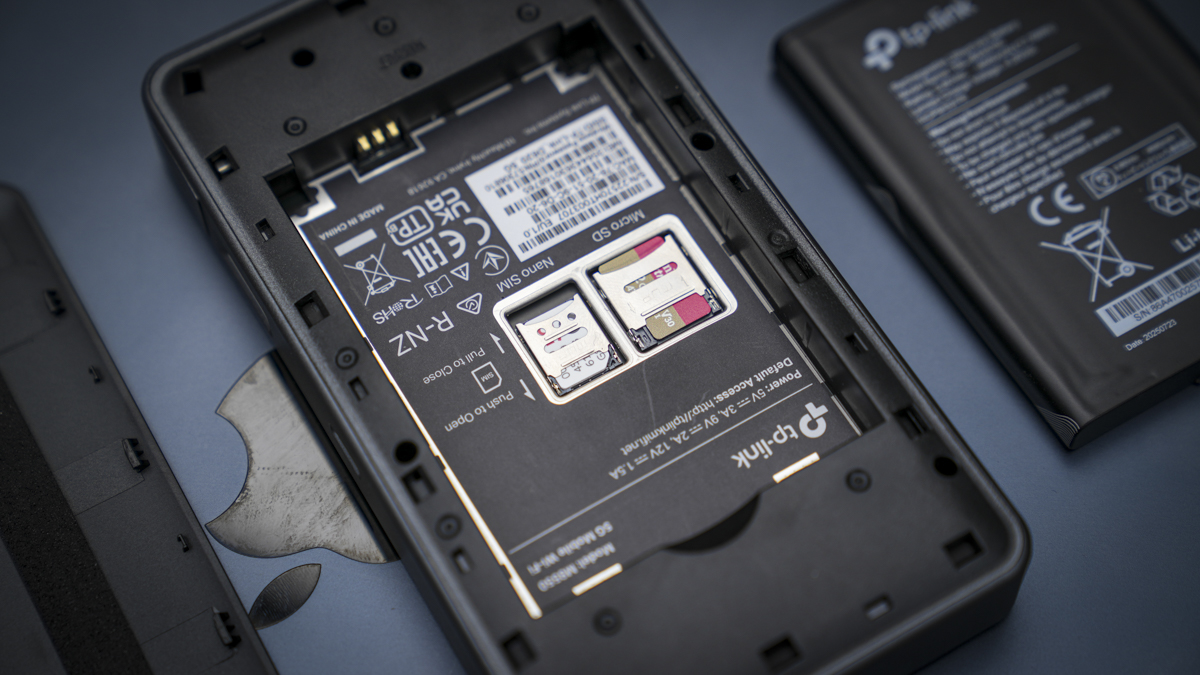
- How much does it cost? From $400 / £400
- When is it out? Available now
- Where can you get it? Via online retailers
Coming from TP-Link, the 5G mobile router M8550 is widely available and can be purchased from most electronics and most major retailers, including Amazon.co.uk.
On top of the cost of the unit itself, you also need to consider a mobile data contract. These are available from most mobile networks for an additional cost to your mobile phone contract, but the price for these will vary greatly depending on the data limit and data speed.
In this test, I’ve used one from Vodafone with unlimited data and full 5G speeds.
TP-Link M8550: Specs
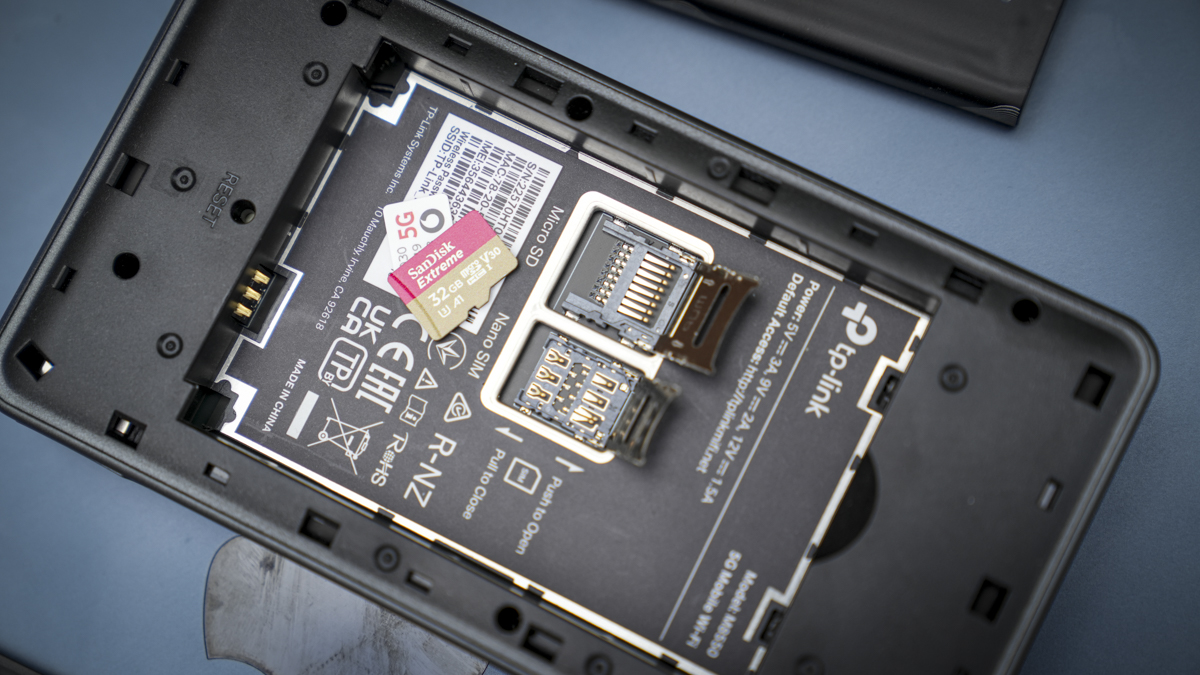
Storage: Micro SD card slot up to 2 TB.
Ports: USB‑C port for power supply, Gigabit WAN/LAN port.
Connectivity: 5G (downlink up to 3.4 Gbps, uplink up to 900 Mbps), 4G (downlink up to 1.6 Gbps), 2.4 GHz, 5 GHz, 6 GHz tri‑band Wi-Fi 6/6E (688 Mbps at 2.4GHz; 2880 Mbps at 5GHz; 2880 Mbps at 6GHz)
Screen: Touchscreen display (2.4″ TFT) for status.
Size: 135 × 73.7 × 20.5 mm.
Accessories: Power adapter, USB‑C cable, battery pack.
TP-Link M8550: Design
It seems there’s a certain style and design that just works for these 5G mobile routers, and the TP-Link M8550 follows a very similar design to the superb Netgear Nighthawk M7 Pro that I’ve looked at recently.
Yet here, they opted for a rectangular rather than square shape, which I have to say, I did come to appreciate through the test; the shape is far easier to slip into a jacket or backpack pocket. The M8550 measures in at 135 × 73.7 × 20.5 mm and weighs 275g, and then a couple of grams in addition for the TF/MicroSD card and Sim.
There were also quite a few small features that stand out nicely, such as the direct connection USB Type-C port for linking in additional power if you’re going through a particularly heavy-use day, and a network LAN port so that you can actually plug this directly into a mobile wired network or your home network, if your standard internet has gone down.
On the front, dominating the top surface, is the large touchscreen that enables you to delve into the settings, check who’s connected to the router, set up username and password, and also the VPN options. It’s very easy to use and offers plenty of flexibility, including showing you the password just in case you forget.
The 2.4in TFT touchscreen isn’t fancy, but it’s well designed to enable you to find your way around the router if you do require anything other than simply connecting to the device.
For the most part, the design is simple, with the only other button on the surface being at the top to power on the device. One of the other features that I really like, and this is similar to other mobile routers, is the fact that it features a removable battery.
Whilst this is proprietary, it does mean that you can carry a couple with you if you know you’re going to need more than 14 hours of use from the device between charges. An additional battery should set you back around $20-40/£20-40.
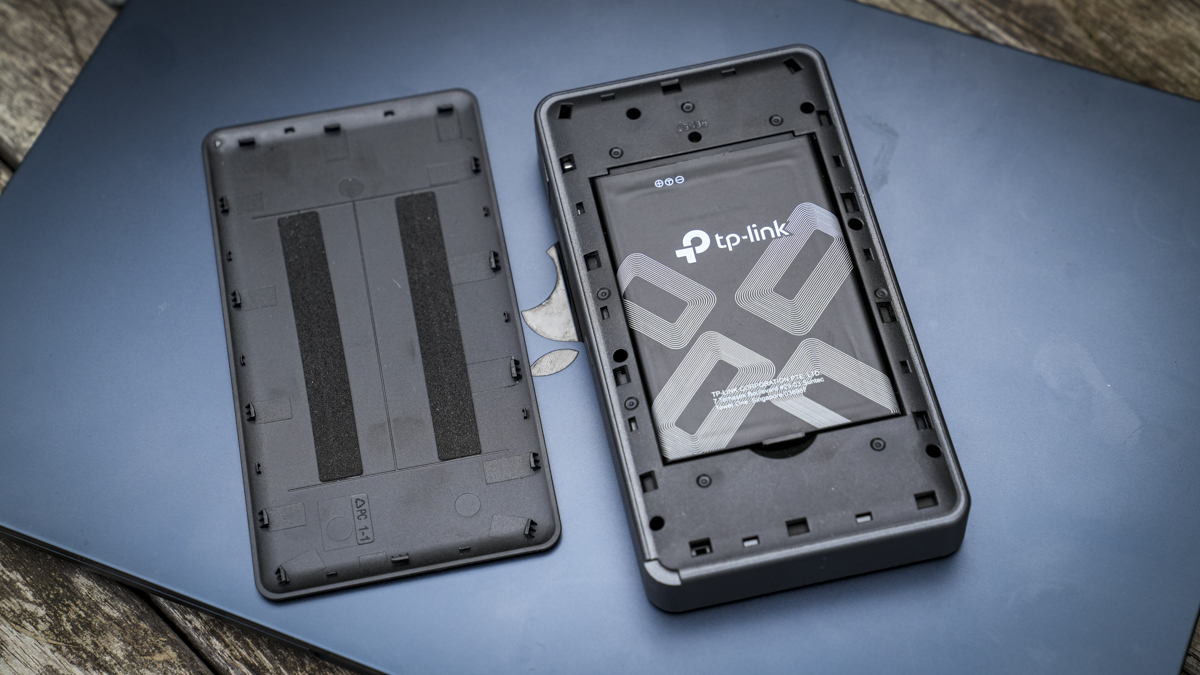
Access to the battery, SIM and MicroSD card slot is made by simply pulling away the back. It’s tightly fitted, but there is a small inset that enables you to get enough purchase to prise the back away.
This is a nifty idea and enables you to store media files on the router so you can play them back on other devices or indeed use it as a mini NAS system whilst you’re out in the field.
The design of the TP-Link M8550 is good, solid, and it feels very robust, but it’s worth pointing out that, whilst it is designed for use outdoors and on the move, it isn’t waterproof or rated with any type of IP or MIL standards for robustness.
TP-Link M8550: Features
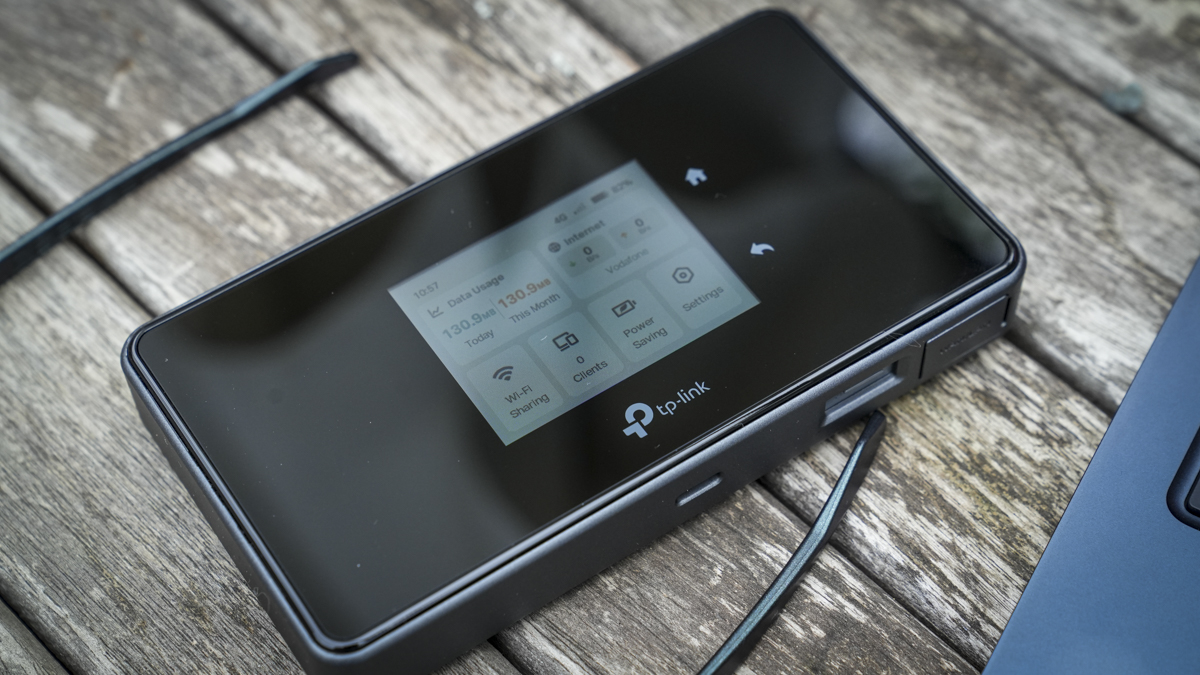
The big feature here is the 5G modem within, which does, of course, mean that you need to purchase a 5G network SIM to make the most of the speed on offer. In ideal situations, this means that you get download speeds of up to 3.4 Gbps using tri-band Wi-Fi 6E and 900 Mbps upload, which, considering the speeds we were seeing just a couple of years ago, is impressive.
One of the big advantages of using one of these mobile 5G routers over, say, just tethering to your mobile phone, is that the connection is far stronger and more robust. So, whilst if you have your mobile phone right next to your laptop, you might not see a huge difference, if you’re using it for an extended period or you’re in the office or on location and need internet connection, you can essentially just leave the box in place. With the large 4680 mAh battery enabling up to 14 hours of use, up to 32 other devices are able to connect and use that single router connection to the mobile network.
If you tried to do this with your mobile phone, firstly, it would struggle with that volume of connections, if it allowed it at all, and secondly, your battery life would likely disappear in just over an hour.
Some of the features that really stand out with the TP-Link M8550 include the fact that it features a LAN port, a gigabit connection, so if you do want to use this as a backup for your office network, or you have a workshop or studio that’s offline, then you can utilise one of these boxes, connected to its own power source, as a constant always-on network without any need for a wired connection to the actual box itself, as it will rely on the mobile network. That network connection is then able to feed through the wired local area network to all of the devices.
This essentially saves you from having to lay data cables from, say, your house to your workshop or garage, or, if you’ve just moved into an office, getting a landline or fibre connection installed in order to get online.
While the box itself isn’t cheap, especially when you factor in the cost of the data contract, compared to getting yourself connected through a more traditional form of communication, it does actually work out relatively inexpensive.
One of the other interesting features about the M8550, which again boosts its appeal over just tethering to your mobile phone, is that you can connect an antenna in order to help boost the reception signal. These screw directly into the contacts on the body. This means that, even if your mobile phone signal is weak, utilising these additional aerials, you’re able to further boost the robust connection this small device can offer.
Another standout feature compared with many other wireless routers is the ability to install a microSD card that can then be accessed by any device connected to the router. This means that, if you want to store music, video files or other content on the router itself, all devices that are connected to it can access them. This in itself is quite a unique feature.
Also notable is the built-in WireGuard VPN encryption, which helps to secure your remote access and protect you online, keeping your ID cloaked from anyone who might try to hack into your system. Again, this is a feature not seen in many other mobile wireless routers, but it adds that extra level of security.
TP-Link M8550: Performance
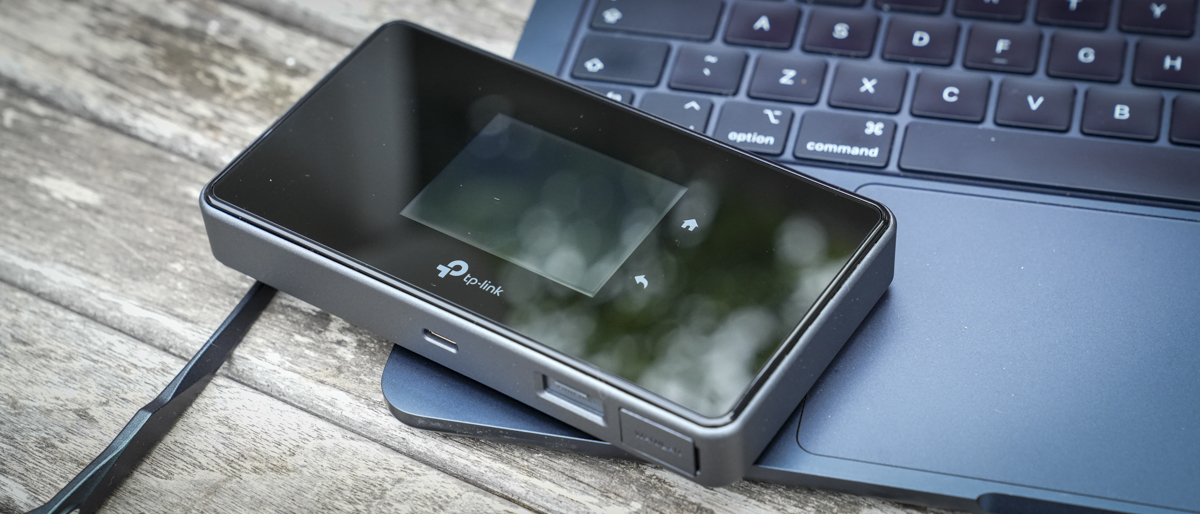
Getting started with the TP-Link 5G mobile router M8550 is simple enough. Removed from the box, you need to pry open the back and install a TF/microSD card for storage. Although this is optional, you also need to install the SIM card from your mobile phone provider (this is a paid-for addition to your standard mobile phone contract, enabling another device to access the internet) and the battery. Once everything is in place, the back can be popped back on, and you can push the power button.
As long as the SIM card is installed, the TP-Link should search for the network and connect, just like your mobile phone. The details will appear on the small TFT screen.
From the outset, I just liked the design and simplicity of the touchscreen. Everything is clearly laid out, with data usage, internet speeds, Wi-Fi sharing, the number of devices connected, power-saving options (very handy when you’re out in the field), and direct access to all of the unit settings.
Essentially, once it’s all set up, all you need to do, whichever mobile device you’re on, is select the Wi-Fi signal from your usual connection options on your laptop, mobile phone or other device. After doing a quick search and entering the username and password, you’re connected to the TP-Link M8550 and can start to browse the internet.
Just like any mobile phone, in order to work, you do need to ensure that it has a 4G or 5G signal. And, like your mobile phone, the strength of that signal appears in a small icon at the top of the screen so you can always see if you need to move around to gain a better signal.
What I actually found during the test was that, whilst in my van, the signal could be quite low. But if I popped the box on top of the van, it would often boost the signal strength, enabling a far stronger connection to my two laptops and mobile phone. The great thing here is that, as long as I had at least 4G with four to five bars, the internet speeds were pretty impressive.
When I went up to Salisbury and sat in a café using the box as my primary connection point on a full 5G connection, I was impressed with the transfer speeds, which were far faster than I was expecting.
Through the use of the box, there were several features that stood out. The first was the data usage display. While I don’t have to worry about that due to being on an unlimited contract, it is interesting to see how much data has been transferred. I also liked the fact that you can see the upload and download speeds all on that screen, so if you’re a bit of a data geek and like to see what’s going on, this particular box is ideal.
Before the real use of the router starts, you then need to either go through the App that’s available for iOS and Android or through the router itself by connecting through your web browser. When trying to connect through the App, I did have a few issues with it recognising the router type, so for the purpose of this test, I went instead through the browser route. Starting by connecting to the router, you can then open a browser, type in http://tplinkmifi.net/, and then register a password and log in. From there, you have access to all the router’s settings, including the advanced options. As a default, two of the options that I activated were the storage sharing, and I made sure that 2.4Ghz as well as 5Ghz were activated. There’s also a 6Ghz option if you have a device that supports it.
I’ve reviewed quite a few of these mobile routers, and this is actually the first one I’ve seen that includes its own slot for a microSD or TF card for storage. It’s a great idea, and essentially, you can use it like a network drive. It takes a little bit to navigate to it through your system, but once done, if you’ve got media files or work files located on the router, anyone with access to the connection should be able to access those files, making it a great option if you’re working with a group of colleagues.
How this works is relatively simple: essentially, from a computer, go to the network and browse or connect to 192.168.1.1, and the SD card should appear ready for use. Then you and anyone else who needs to connect can. If you need more security around the access to the storage, then you can set a username and a password through the setup process.
The other feature I really liked was that it has a USB Type-C port and a LAN port. The USB-C port enables PD power, so if you’re using this as your main network connection through the day, you can plug in an external power source (for example, a Jackery 1000 V2) so that the battery remains topped up. This is especially useful if it’s being used for intensive downloads and uploads, which tests the 14-hour battery life quoted by TP-Link. This meant that in the van I could run the Sapphire Edge Ai 370 Mini connected to the KTC Monitor with internet provided through the M8550.
The fact that it includes that LAN port also means you can wire it directly into a router and utilise that as a wired connection to your laptops, Mini PC’s and other network-enabled machines. If you’re using that microSD card inside, or you’ve plugged in a network-attached storage drive, then it gives you easy access to those, again, useful if you’re working collaboratively out in the field.
The other big feature here is the VPN WireGuard, again to activate this all you need to do is to pop into the advanced settings and switch on enable VPN client. Once that small update has been applied you will then be running behind a VPN with no other settings or adjustments needing to be made. This just makes it a far quicker and easier solution than most other VPN software solutions.
For me, the size and design of the device just really worked. The rectangular rather than square form factor meant that it slipped easily into pockets and backpacks without issue. If you are travelling light or have a more streamlined day-to-day business setup, this is going to fit neatly into any bag without adding too much weight or bulk.
Essentially, for most users, the main point here is just to remember to keep it charged so it’s always ready to go. But if you do work in a city and worry about using public Wi-Fi, or when you tether to your phone on the commute, you always find the battery running out too quickly, then something like the TP-Link 5G router M8550 could be an ideal option.
TP-Link M8550: Final verdict

For me, working out in the field and away from the main internet, having a wireless 5G router is essential. And whilst this isn’t the brand or unit I use on a regular basis, there are several things that really appealed to me through this review.
The first is the PD power, which is essential; it means you can always have the router ready to go, and it’s not going to run out of juice when you need it most, often when a deadline is approaching.
I also really liked the touchscreen; it’s just easy to navigate, and the fact that data is shown on the front screen makes it quite interesting for anyone who likes to keep track. Then you have the wired LAN connection, which just makes sense when you’re working in the field and enables you to connect a drive or utilise it in the studio or on location where there would otherwise be no internet connection.
Using a mobile network gives you that reliability, and as long as you’ve got a decent signal, then you’re going to get decent internet speed. It might not match your office broadband, but with the speed that 5G enables, both download and upload speeds are impressive, more than enough for video conferencing, streaming media, and uploading/downloading image and video files.
For me, however, one of the big features here has to be that internal microSD card for storage. It just means that, if you’re working with others and need an easy way to pull certain files, such as a shooting list or schedule, then having this small box with all that data accessible remotely by everyone working on the project just makes life easier.
The price is what really struck me about the TP-Link M8550. The quality of the connection and the ability to boost it with antennas just reinforces that this is an exceptionally capable, fast solution. And the fact that you can connect so many devices, although I didn’t reach the limit, is impressive.
In almost any situation where you need a mobile data connection, a mobile 5G router is an excellent solution, and so far, the TP-Link M8550 is one of the best that I’ve looked at for everyday use by most users.
Should I buy a TP-Link M8550?

|
Value |
Compared with competitors, the price and speed are exceptionally good. |
5/5 |
|
Design |
Rectangular shape is ergonomic and fits neatly into a jacket or bag pocket. |
4.5/5 |
|
Features |
All the standard features, but the microSD option and VPN take it to the next level. |
4.5/5 |
|
Performance |
Connection speeds are robust; performance was excellent. |
5/5 |
|
Overall |
A solid wireless router with additional features that put it ahead of the rest. |
5/5 |
Buy it if…
Don’t buy it if…
For more connectivity solutions, we’ve reviewed the best Wi-Fi routers.




